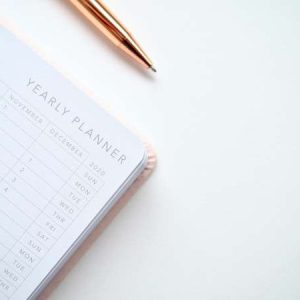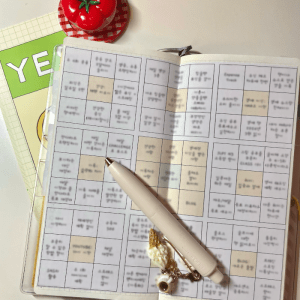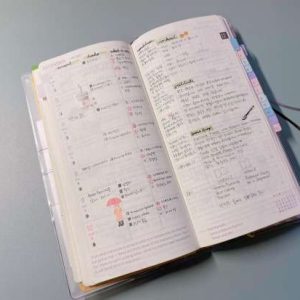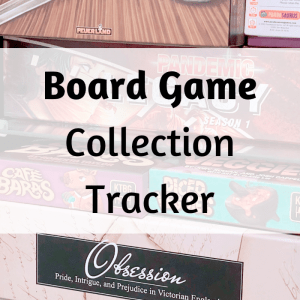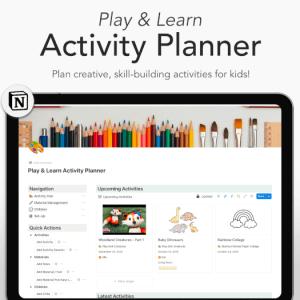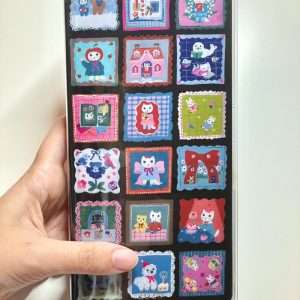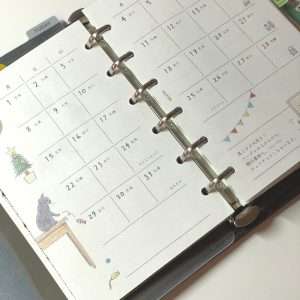Digital Journaling 101: Best Apps, Benefits, Tips and More
I love analog journaling—writing on paper, decorating pages, and slowing down. But if someone asked whether I could replace all my digital journals with analog ones, my answer would be no. Certain features in digital apps are essential to how I stay productive. For anything that needs frequent editing, automation, or better organization, I always turn to digital. Analog journaling is more about calming and creativity for me, while digital journaling supports efficiency and clarity.
In this guide, I’ll walk you through the benefits of digital journaling, the types of tools available, and how I personally combine analog and digital systems.
If you’re interested in paper journaling, check out my Ultimate Guide to Analog Journaling.
Table of Contents
What is Digital Journaling?
Digital journaling uses apps and devices to record your thoughts, with features like multimedia, cloud storage, and customizable templates. It helps you stay organized, access entries quickly, and sync across devices.
If you’re new to digital journaling, here are some common questions people ask:
➤ What is the best app for digital journaling?
The best app depends on your needs! Notion is great for structured journaling, while GoodNotes is perfect for handwriting. For multimedia entries, Day One is a top choice.
➤ Is digital journaling better than paper journaling?
For me, digital journaling is incredibly convenient because it’s searchable, cloud-based, and multimedia-friendly. But I could never give up the distraction-free environment of paper journaling or the sense of calm I get from writing by hand. Both have their own strengths, and I use them side by side depending on my needs.
➤ How do I start digital journaling?
Choose an app that fits your style, set up a template, and start writing! Notion, Day One, and GoodNotes are great starting points.
➤ Are digital journal apps free?
Some apps like Notion have free versions, while others (like Day One and 5 Minute Journal) require a subscription for full features. I’ve used both Notion and GoodNotes for a long time. Notion is especially great because it’s completely free for personal use—I’ve never had to pay for the features I need. GoodNotes, on the other hand, introduced a new pricing model with version 6, so I’ve been hesitant to upgrade.
Not sure which digital journaling method is right for you? This guide covers the benefits, journal types, and top apps to help you find the best fit for your style.
My Experience: Mixing Analogue and Digital Journaling
While my main journaling method is analogue—I love writing on paper and using stickers and other decorations—there are several areas where I prefer digital journaling. I choose digital when I need to modify the content frequently, jot down temporary items, use a calculator, include higher-quality photos, or add online references. Here’s how I use digital tools in my journaling routine:
- Spending Journal: I track expenses digitally for better organization and quick calculations.
- Brainstorming: Quick idea dumps and concept organization are easier in digital form.
- Quick To-Dos: I jot down short-term tasks digitally for easy updates.
- Visual Journals: Apps like Procreate allow me to create digital sketches and art-based journals.
- Knitting Journal: I document projects with photos, detailed progress, and links to patterns.
- Travel Planning: I save ticket information, Google Maps links, and itineraries.
- Recipes: Having a digital recipe journal means I can access it anywhere.
- Investment Journal: I track financial goals and stock updates in digital format.
- Class Notes: Digital note-taking allows me to organize and revise efficiently.
For most of these, I use Notion, as its different views—Gallery, Table, and List—make customization effortless. For example, my knitting journal is set in Gallery view so that my finished project photos are visible right away. I can also add yarn details, pattern links, and screenshots of tricky parts for reference.
The Benefits of Digital Journals: How They Work for Me and Could Work for You

Flexibility and Customization
I love how digital journals allow me to quickly modify content, reorganize sections, and update entries without erasing or rewriting. The ability to personalize layouts, use different fonts, and integrate colors makes digital journaling an enjoyable experience.
Easy Access and Organization
I appreciate how digital journaling helps me stay organized. With tags, folders, and a powerful search function, I can quickly find old notes, whether it’s a travel itinerary, a past knitting project, or a financial entry.
Integration with Other Apps
One of my favorite aspects of digital journaling is how easily I can integrate it with other apps. I use links to patterns in my knitting journal, connect my travel planning notes with Google Maps, and add references directly to my investment journal.
Environmentally Friendly
Digital journaling reduces paper waste, making it a more sustainable choice. Enjoy a clutter-free space while being eco-conscious.
Multimedia Capabilities
I love that I can add high-quality photos, videos, and voice recordings to my digital journals—especially for visual journals and knitting logs. In my knitting journal, I include time-lapse videos, voice notes for patterns, and tutorial links to tricky stitches. This helps me track progress, improve my skills, and keep all references in one place.
Exploring Different Types of Digital Journals
- Note-Taking Apps: Ideal for quick notes, these apps offer simple, efficient interfaces. Examples include GoodNotes and Microsoft OneNote.
- Dedicated Journaling Apps: Specifically designed for journaling, these apps come with features like prompts and mood tracking. Popular choices are Day One and Journey.
- Bullet Journal Apps: Mimicking traditional bullet journals, these apps allow for customizable layouts to manage tasks and schedules. Consider Notion or GoodNotes.
- Visual Journals: Focus on creativity with apps that support drawing and multimedia. Procreate and Adobe Fresco are great options for artists.
- Daily Diary Apps: Perfect for daily reflections, these apps offer straightforward interfaces with features for tracking moods and goals. Check out Reflectly or Penzu.
I’ve found that digital journaling easily adapts to whatever style or purpose I need. From visual to structured formats, I like mixing different types depending on my mood. Its flexibility lets me create a system that grows with my lifestyle and creativity.
Finding the Best Digital Journal for You
Choosing the right digital journal depends on several factors, as different apps cater to different needs. Whether you’re looking for a journal to document daily reflections, organize projects, or track creative pursuits, here are key elements to consider:
Features and Functionality
Think about what you want from a digital journal. Do you need multimedia support for adding photos and videos? Are you looking for integration with productivity tools like calendars or task managers? Some apps offer advanced search and tagging features, while others focus on simplicity.
User Interface
The best journaling app is one you enjoy using. A clean and intuitive interface makes it easier to jot down entries without distractions. If an app feels cluttered or complicated, you might not use it consistently.
Device Compatibility
Make sure the app is available on the devices you use the most. Some apps are designed for mobile-first experiences, while others work better on tablets or desktop computers. If you use multiple devices, consider apps with cloud sync capabilities.
Customization Options
If you like personalizing your journal, look for an app that offers customizable templates, themes, and layouts. Some digital journals allow you to structure entries in different ways, such as bullet journaling, mind maps, or timeline views.
Security and Privacy
If you want to make sure your digital journal is protected from other people, consider using apps with security features. Some platforms allow for private or locked pages within a journal, giving an extra layer of security.
Collaboration and Sharing
If you’re journaling for projects or creative work, some apps support shared notes and team access—great for brainstorming or group reflections. I use a shared Notion workspace with my family as our travel planner. It helps us organize trip details, store tickets, share plans, and keep everything—from itineraries to Google Maps links—in one place.
Cost
Some apps are free with basic features, while others require a subscription for premium functionalities or in-app purchases. I used to avoid subscription models, but nowadays, many apps offer free trials. I usually take advantage of a trial period to test whether an app fits my needs before committing to a subscription. This helps me determine if the premium features are worth the investment and if the app truly enhances my journaling experience.
By evaluating these aspects, you’ll be able to find a digital journaling app that fits your lifestyle and enhances your journaling experience.
What Are the Best Digital Journal Apps?
With so many digital journaling apps out there, it can be hard to choose the right one. I’ve tried quite a few myself, and I’ve learned that no single app does everything perfectly. Some are great for structure and organization, while others shine when it comes to handwriting or quick daily entries. Here’s a comparison of the ones I’ve found most useful—you might find your perfect match among them.
Notion – Best for Customization & Organization
⭐ Best For: Structured journaling, planning, and organization
💡 Key Features: Custom templates, databases, integration with productivity tools
✅ Pros:
- Highly customizable for structured journaling
- Works on multiple devices (Web, Windows, Mac, iOS, Android)
- Free plan available with powerful features
❌ Cons:
- Steep learning curve for beginners
- No handwriting support
GoodNotes – Best for Handwritten Digital Journals
⭐ Best For: Handwritten journaling, digital planning
💡 Key Features: Handwriting recognition, PDF annotation, cloud sync
✅ Pros:
- Perfect for handwriting (works well with Apple Pencil)
- PDF import & annotation for organizing notes
❌ Cons:
- iOS only (not available on Windows or Android)
- Lacks robust search & organization tools
- Limited free version (subscription or one-time purchase needed for full features)
Day One – Best for Multimedia & Personal Journaling
⭐ Best For: Private journaling, adding photos/videos
💡 Key Features: Mood tracking, multimedia support, automatic backups
✅ Pros:
- Clean, distraction-free interface
- Supports photos, voice recordings, and videos
- Encrypted for privacy
❌ Cons:
- Limited free version (premium subscription needed for full features)
- Only available on iOS & Mac
5 Minute Journal – Best for Quick Daily Reflections
⭐ Best For: Guided journaling, gratitude tracking
💡 Key Features: Daily prompts, goal setting, positive habit-building
✅ Pros:
- Great for beginners (simple format)
- Helps build a gratitude habit
- Available on iOS & Android
❌ Cons:
- Subscription required for full access
- Lacks deep customization
To help you choose the right digital journal app, here’s a quick comparison of their key features, platforms, and pricing:
Comparison of Digital Journaling Apps
| App | Best For | Key Features | Platform | Price |
|---|---|---|---|---|
| Notion | Highly customizable journaling & organization | Templates, databases, integration with other tools | Web, Windows, Mac, iOS, Android | Free with paid upgrades |
| GoodNotes | Handwritten notes & digital planning | Handwriting support, PDF annotation, cloud sync | iOS, iPadOS, Mac | One-time purchase or subscription |
| Day One | Dedicated journaling with prompts & multimedia | Clean interface, daily prompts, photo & video support | iOS, Mac | Free with premium subscription |
| 5 Minute Journal | Quick daily reflections & gratitude tracking | Guided journaling, goal-setting, positive mindset focus | iOS, Android | Subscription-based |
By exploring these options and considering what features matter most to you, you’ll find a digital journal that enhances your journaling practice and fits your lifestyle.
Wrapping Up
Digital journaling offers a versatile and efficient way to capture your thoughts, track your goals, and enhance creativity. With a range of apps available, you can find the perfect tool to suit your needs, whether you’re looking for advanced features, ease of use, or multimedia capabilities.
For me, a mix of analogue and digital works best. I love the tactile feel of paper journaling but appreciate the convenience of digital notes for specific tasks. If you’re considering digital journaling, think about what you need from a journaling app and how it fits into your routine.
Start your digital journaling journey today and experience the benefits of this modern approach!
📝 Must-Try Journaling Ideas & Inspiration
- Hobonichi Weeks 2026 Setup: How I Set Up My Planner for 2026
- Free Mandala Chart Template for Your New Year Goals
- Time Tracker for Hobonichi Weeks & A6 (Free Download)
- JLPT Study Planner with Hobonichi: Timeline and Layout Tips
- Hobonichi Weeks vs Traveler’s Notebook: Which One Fits You?
Want to level up your journaling practice? Explore tips, prompts, and organization ideas: Browse All Journaling Tips
🖊️ Popular Stationery Reviews
- Best 2026 Planners: Top Picks for Every Planning Style
- Hobonichi Weeks 2026 Review: Purchase & First Look
- Hobonichi Weeks vs Traveler’s Notebook: Which One Fits You?
- Hobonichi Techo 2026 Lineup: My Picks & What to Buy
- Stamping Essentials: My Must-Have Tools for Better Results
Looking for the best stationery to enhance your journaling experience? Check out all my Stationery Reviews for detailed insights, product recommendations, and tips to help you choose the perfect tools for your creative projects!


